
The Central Bridge, now known as the Cox Bridge, has played an integral role in Lowell’s past and continues to play an important role today as a direct gateway to downtown Lowell.
The Central Bridge began as a ferry service across the Merrimack River between Dracut and East Chelmsford. An early mention of a ferry appears in a deed of conveyance of a 100 acres from John Colburn to Robert Hildreth dated Jan. 3, 1735. The ferry operation passed various hands until it came to Joseph Bradley, who would later sell the ferry rights to the Central Bridge Corporation in 1827 for $1,050.
The Central Bridge Corporation, composed of prominent Dracut residents, was incorporated on Feb. 24, 1825. These town leaders signed an agreement with Luke S. Rand of Vermont to build a bridge over the Merrimack River between East Chelmsford (soon to become Lowell) and Dracut fairly close to the location of the ferry operation. Building a bridge in the 1820s was a big undertaking, especially where the river was at least 32 feet deep in some places, but Luke Rand was up to the task.
By the end of 1826, the bridge, 540 feet long and “of the old wooden type”, was in use. Two stages crossed it daily. It cost $21,000 to build.

To help pay for building the bridge, as well as to cover maintenance costs and provide income for the Central Bridge Corporation, tolls were collected from pedestrians, drivers of wheeled vehicles, and cattle drivers. Dracut residents grumbled that the tolls were too high and sued the Corporation. Through the years, in spite of some fee reductions, there remained discontent. After annexations of parts of Dracut (Centralville and parts of Christian Hill) to Lowell in 1851, and an additional one in 1874, the City of Lowell gained control of the bridge and the tolls were abolished. In 1844, the bridge was rebuilt. Sources differ as to whether the original bridge was covered, but, in 1849, it had two wooden covered sides for pedestrians and an open roadway.
In 1862, as later photos with the date “1862” engraved on the central arch testify, the bridge was again rebuilt at a cost of $33,000. Luke Rand’s strong piers for the original bridge also served as piers for this one. The bridge’s sidewalks were wood covered with windows while the central roadway was “hypaethral” – open to the sky. Road posts guarded the entrances to prevent runaway horses from scaring or hurting pedestrians. The roadway had a one horse-car track. When, in 1874, the planked roadway was replaced with paved wood, the horse railroad extended its tracks to Centralville. In 1879, the railway was laid in concrete to strengthen the bridge thrown out of line by west winds.
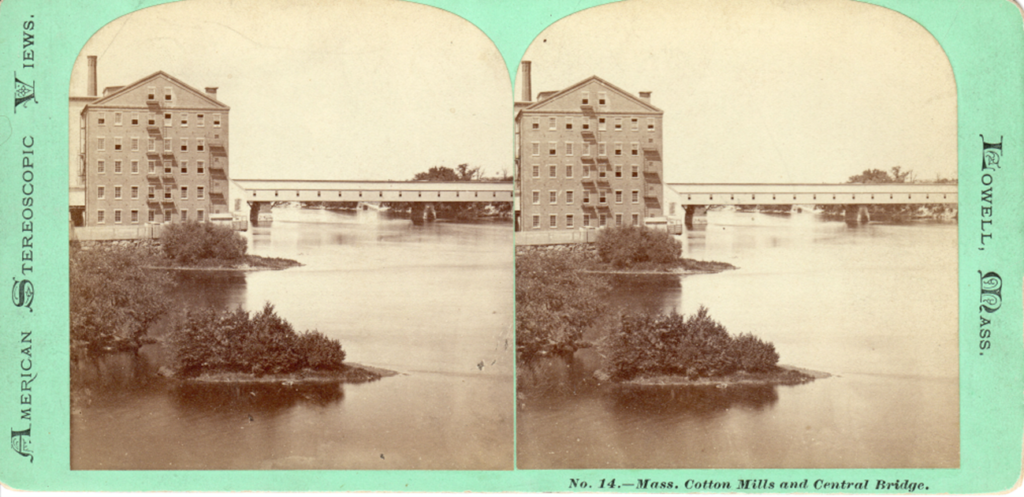
One of Lowell’s most spectacular disasters happened on Aug. 5, 1882, when the Central Bridge caught on fire. The first alarm was rung around 3:00 AM from Box 46 at the corner of First and Bridge Streets. Spectators gathered to see this wooden structure in flames and to witness firemen struggling to put them out from the roofs of mills. As the wind was rather calm, the fire did not spread to the wooden window frames of the mills, but still burning cinders could be found in Centralville on Myrtle and Fremont Streets.
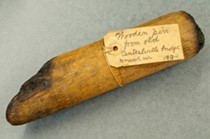
Cause of this blaze? One theory suggested that sparks from a dummy engine used to pump water (from a dam just west of the bridge where a foundation for an extension of the Boott was being built) ignited the fire. This theory was debunked – the engine was too far away to cause damage. Others believed that the careless toss of a lit match or cigar was responsible for the fire.
Whatever the cause, the result was that the residents of Centralville were cut off from the city and from services and needed supplies such as gas for lighting. More than that, many Centralville residents were unable to get their place of work, unless they were the lucky few who owned horses and could take the extra time to cross the Merrimack further down using the Pawtucket Bridge.
Soon various ways were devised to remedy the situation – canal boats were used, a floating bridge was installed, teams went around crossing at the Pawtucket Bridge, a temporary bridge for carriages was put in place that went from First Street to the Immaculate Conception Church, and, finally, a pile bridge was installed for pedestrian use. The pile bridge was quickly put into place and a welcomed relief for the Centralville residents who relied on the bridge as a way to walk to work. The only complaint being that this pedestrian pile bridge was uncovered and left those crossing exposed to the elements. After a long cold winter, residents were known to remark that the builders of the old bridge knew what they were doing when they made it a covered bridge.
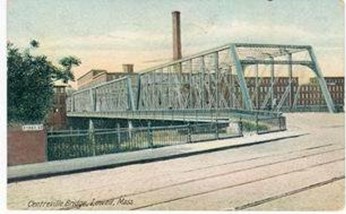
A long awaited new bridge was completed in September, 1883 with a price tag of $133,441.
A Courier Citizen news article and photo on Aug. 2, 1905, informed the reader that repair work had started on the Central Bridge and would be done piecemeal so that the bridge would stay in operation. This must have eased concerns of those who crossed the bridge daily to work in the mills or in downtown Lowell. The track lines were to be replaced by newer and heavier rail.
As if the fire of 1882 wasn’t calamity enough, the bridge was again destroyed. This time the great flood of 1936 was the culprit.
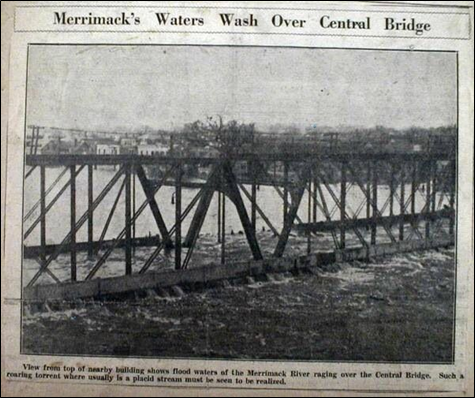
The American Bridge Company was contracted to erect a new steel bridge on the site of the old historic bridge which is the bridge that still stands today.
The building of the new Central Bridge generated a movement to rename it. Suggested names included the John Jacob Rogers Bridge, Gen. Ben Butler Bridge, the Boott Bridge, and the Dudley L. Page Bridge, this last being a serious contender even winning a vote in Sampascoopies, a popular column in the Lowell Sun.
On Nov. 17, 1937, the Lowell City Council unanimously approved changing the name of the new Central Bridge to the Dudley L. Page Bridge.
In June of 1938, the City Council voted to rescind its action of Nov. 1937 in naming the new Central Bridge in honor of Dudley L. Page and to attest that the bridge officially will be called the Central Bridge. It explained that it was following the dictates of the federal government which had donated money for the construction of the bridge and cited its rule against naming the bridge for a living person.
Life went on. Boards went up each winter to protect pedestrians from the cold blowing winds and came down each spring. But the bridge would receive a new name in 1986. A plaque on the Centralville side of the bridge says “John E. Cox Memorial Bridge, Dedicated on Nov. 2, 1986, By the grateful people of Lowell in appreciation of his many years of faithful service to his community.” This is the current name of the bridge christened after a member of a prominent Centralville family and former city councilor, but old habits persist as one still hears folks talk about the Bridge Street Bridge.
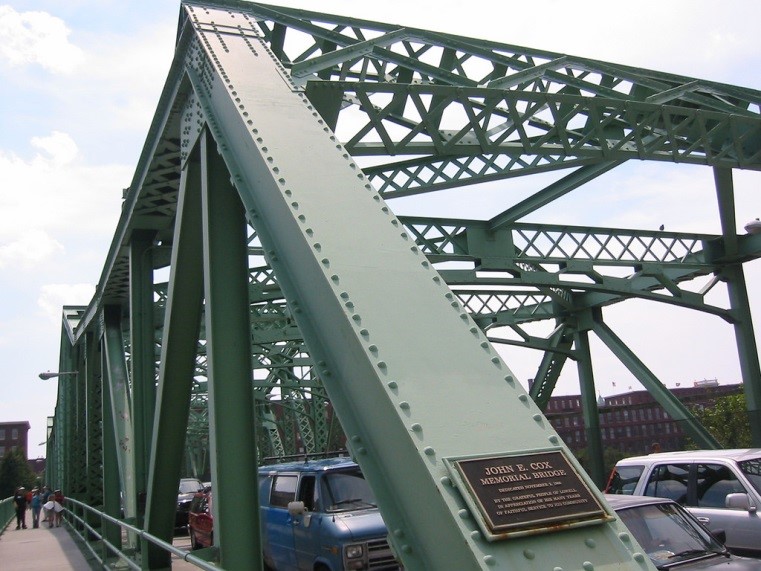
No consideration of this bridge, which spans the historic Merrimack River, served to develop parts of early Dracut and Lowell, and is a direct gateway to downtown Lowell, would be complete without mentioning that the structure itself with its three main spans is today considered technologically significant as a fine example of a small scale “cantilever truss” bridge.
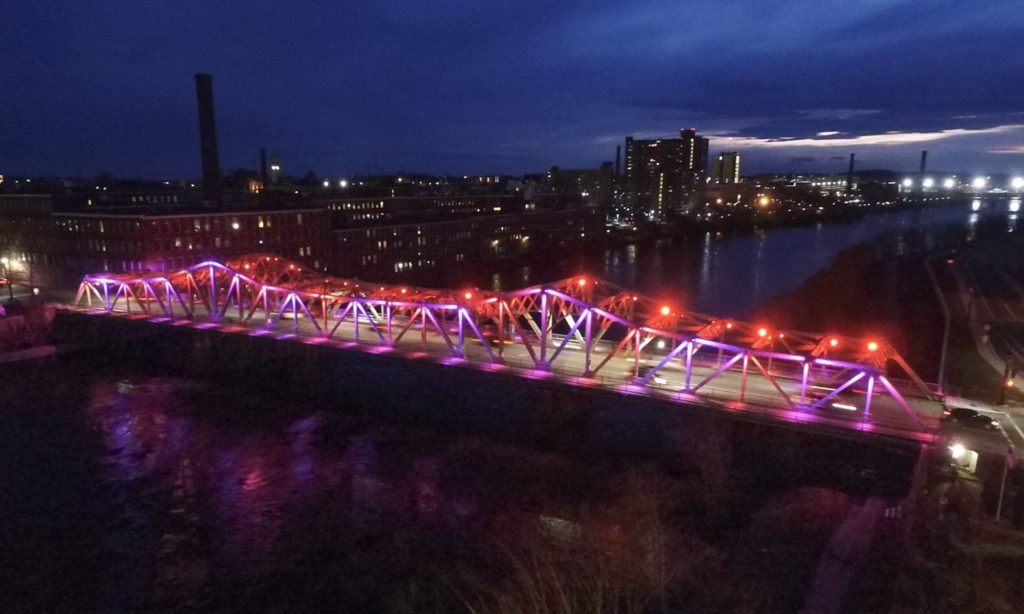
In May, 2018 the Cox Bridge lighting debuted. It was the first major project for the Waterways Vitality Initiative. Through private donations, more than 200 multi-colored LED fixtures were installed. Every night it lights up with a seasonal show, holiday displays, or cause-based lighting.
Special thanks to Pauline M. Golec for the research and writing of the John E. Cox Memorial Bridge history, prepared for the May 2018 Cox Bridge lighting events.

